Abstract
CTP (ATP) binding to the T or R state causes reorientation of several key residues and results in a decrease (increase) in the size of the nucleotide binding site and a related decrease (increase) in the extension of the outer parts of the dimer of the regulatory chains, R1 and R6. As a result, CTP pinches the regulatory dimers together by 0.3 A in the R state; ATP pushes the regulatory dimers apart by 0.3 A in the T state. These changes influence key residues in the R1-C1 interface of the R state and the R1-C1 and R1-C4 interfaces of the T state, such that the separation of catalytic trimers (c3 ... c3) is decreased by 0.5 A by CTP in the R state and increased by 0.4 A by ATP in the T state. (Smaller effects on c3 ... c3 are observed when CTP binds to the sterically crowded T state or when ATP binds to the elongated R state). These changes reorient key residues in the active site (e.g., catalytic chain residue Arg-229, a residue involved in aspartate binding). This pattern for action of CTP and ATP in perturbing the regulatory dimer, and consequently both the structure and flexibility in critical parts of the T state or R state, is called the nucleotide perturbation mechanism.
Full text
PDF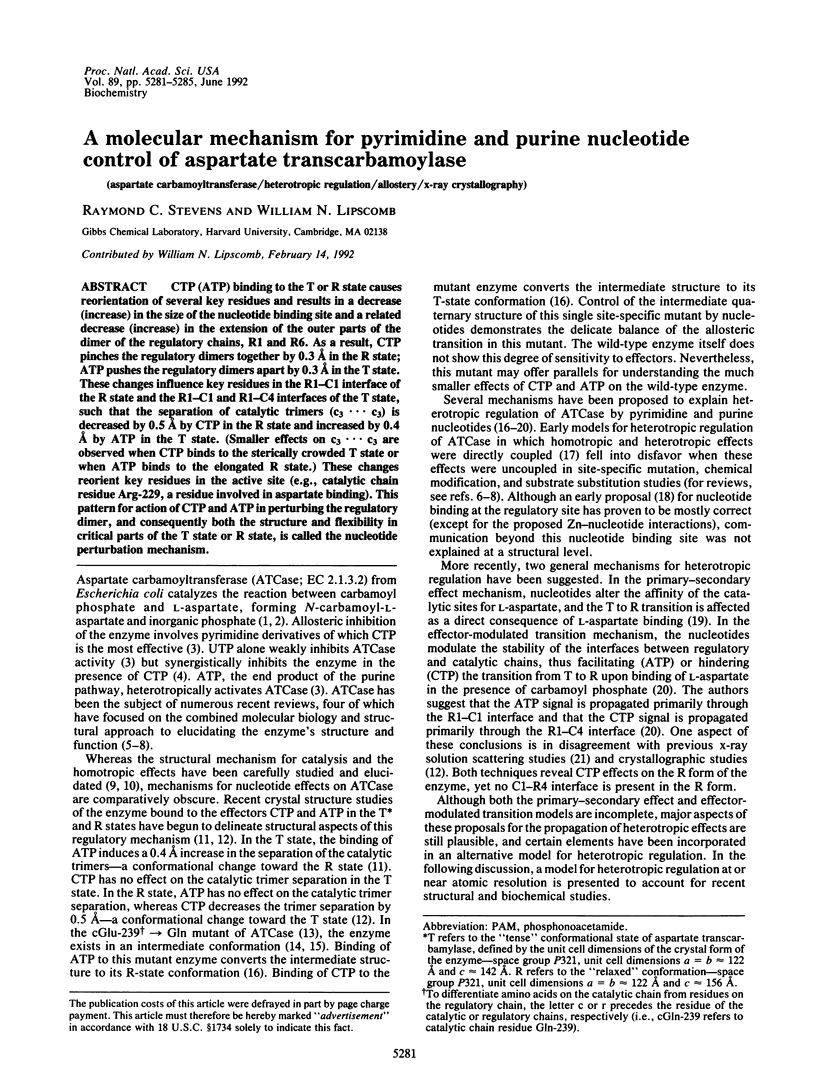
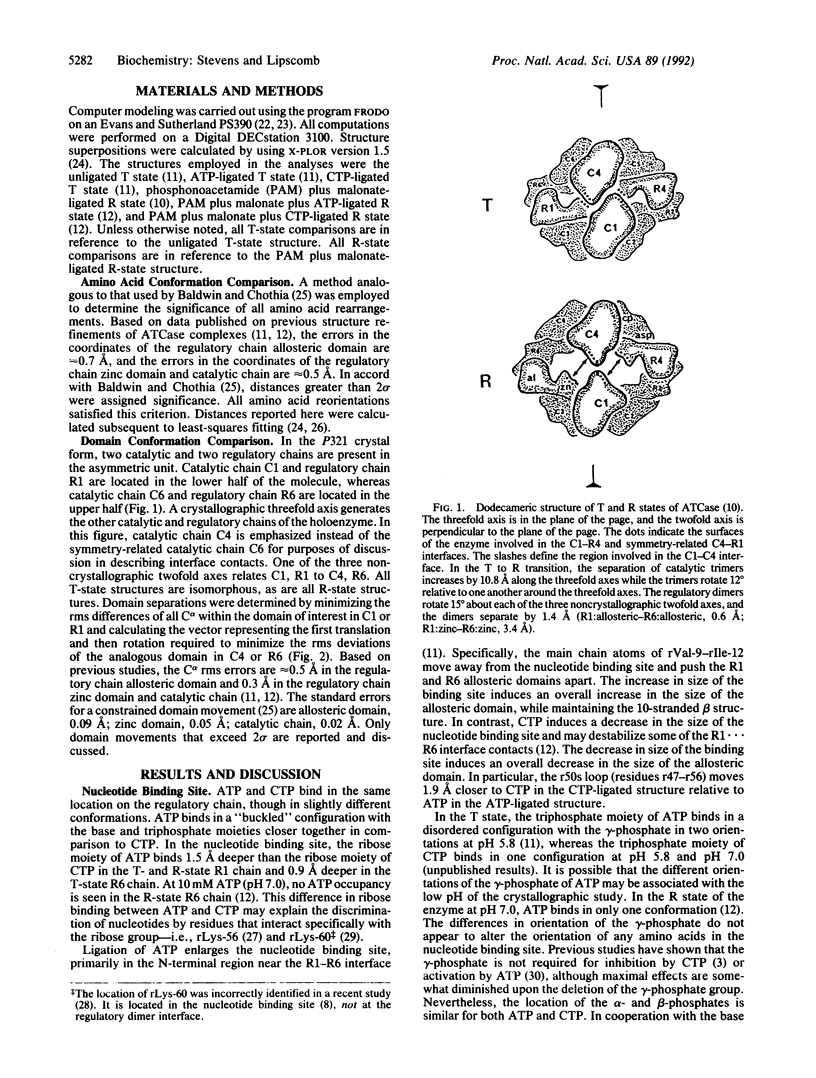
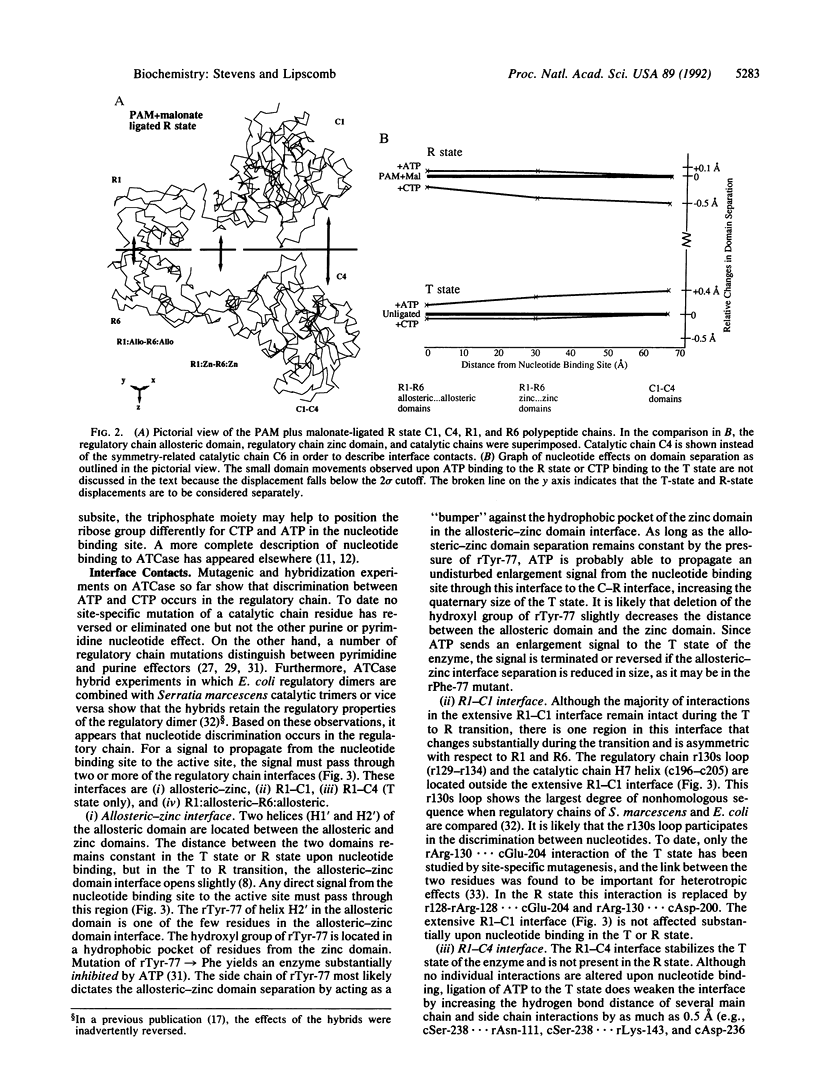
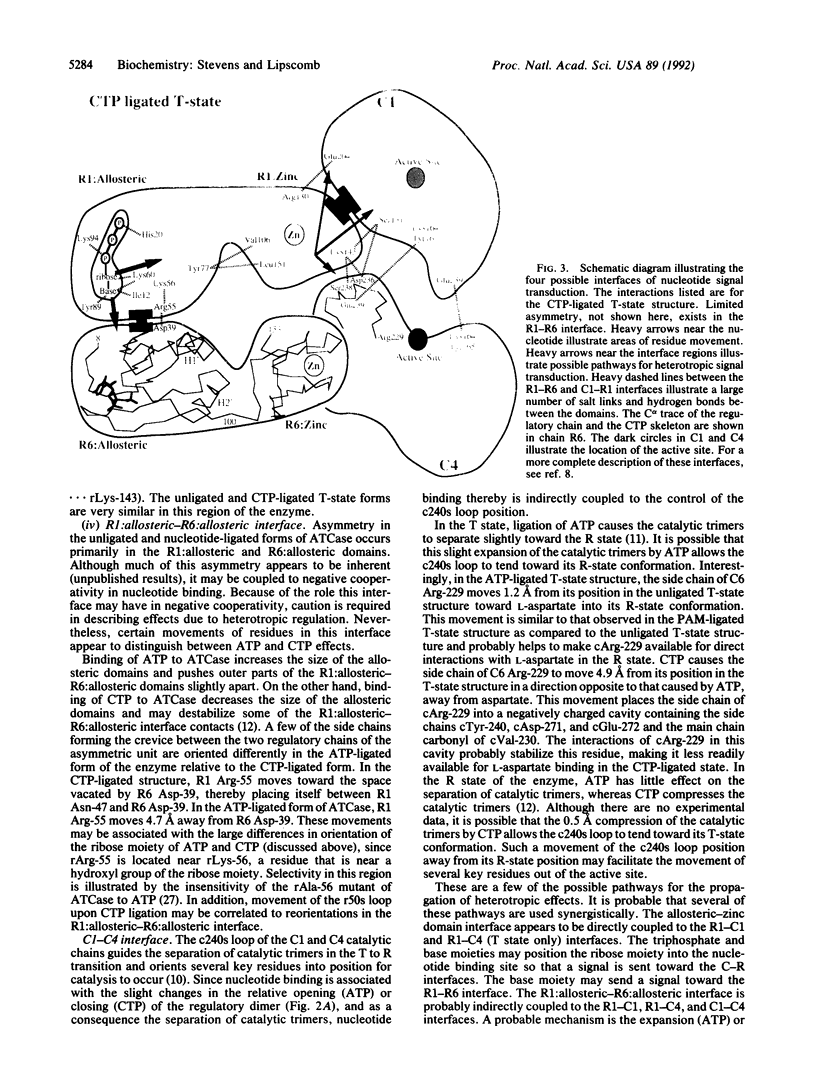
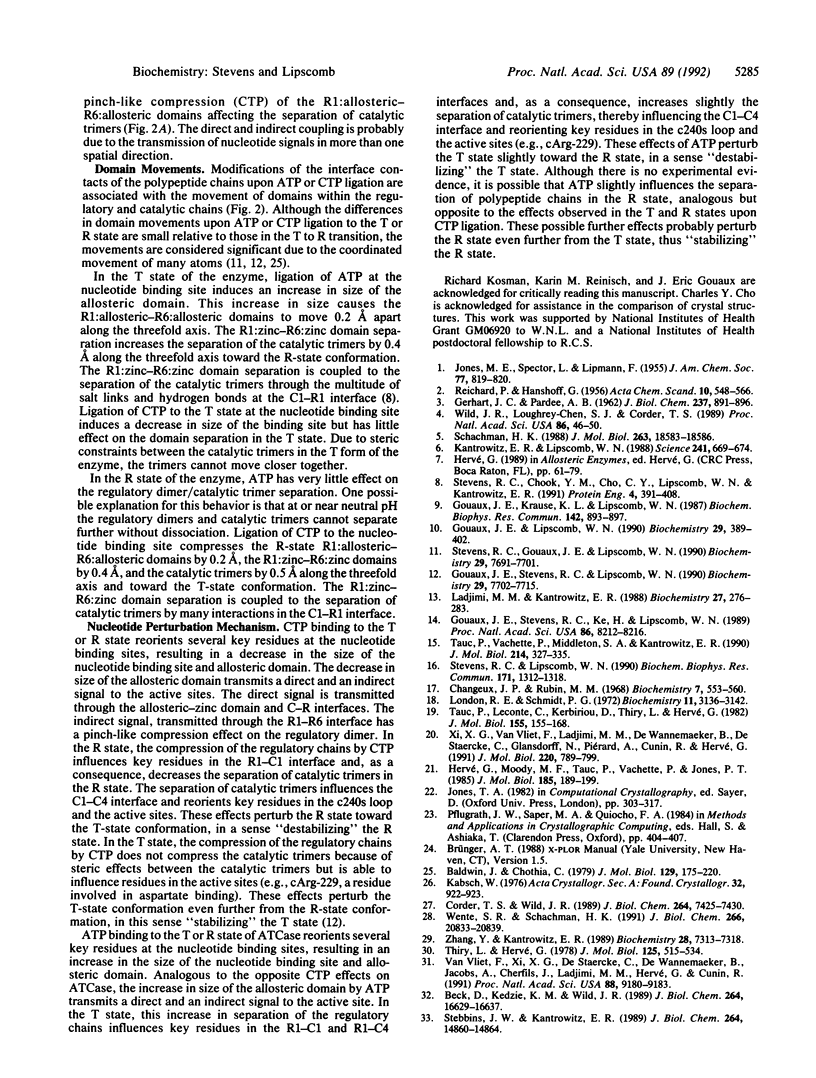
Images in this article
Selected References
These references are in PubMed. This may not be the complete list of references from this article.
- Baldwin J., Chothia C. Haemoglobin: the structural changes related to ligand binding and its allosteric mechanism. J Mol Biol. 1979 Apr 5;129(2):175–220. doi: 10.1016/0022-2836(79)90277-8. [DOI] [PubMed] [Google Scholar]
- Beck D., Kedzie K. M., Wild J. R. Comparison of the aspartate transcarbamoylases from Serratia marcescens and Escherichia coli. J Biol Chem. 1989 Oct 5;264(28):16629–16637. [PubMed] [Google Scholar]
- Changeux J. P., Rubin M. M. Allosteric interactions in aspartate transcarbamylase. 3. Interpretation of experimental data in terms of the model of Monod, Wyman, and Changeux. Biochemistry. 1968 Feb;7(2):553–561. doi: 10.1021/bi00842a601. [DOI] [PubMed] [Google Scholar]
- Corder T. S., Wild J. R. Discrimination between nucleotide effector responses of aspartate transcarbamoylase due to a single site substitution in the allosteric binding site. J Biol Chem. 1989 May 5;264(13):7425–7430. [PubMed] [Google Scholar]
- GERHART J. C., PARDEE A. B. The enzymology of control by feedback inhibition. J Biol Chem. 1962 Mar;237:891–896. [PubMed] [Google Scholar]
- Gouaux J. E., Krause K. L., Lipscomb W. N. The catalytic mechanism of Escherichia coli aspartate carbamoyltransferase: a molecular modelling study. Biochem Biophys Res Commun. 1987 Feb 13;142(3):893–897. doi: 10.1016/0006-291x(87)91497-5. [DOI] [PubMed] [Google Scholar]
- Gouaux J. E., Lipscomb W. N. Crystal structures of phosphonoacetamide ligated T and phosphonoacetamide and malonate ligated R states of aspartate carbamoyltransferase at 2.8-A resolution and neutral pH. Biochemistry. 1990 Jan 16;29(2):389–402. doi: 10.1021/bi00454a013. [DOI] [PubMed] [Google Scholar]
- Gouaux J. E., Stevens R. C., Ke H. M., Lipscomb W. N. Crystal structure of the Glu-239----Gln mutant of aspartate carbamoyltransferase at 3.1-A resolution: an intermediate quaternary structure. Proc Natl Acad Sci U S A. 1989 Nov;86(21):8212–8216. doi: 10.1073/pnas.86.21.8212. [DOI] [PMC free article] [PubMed] [Google Scholar]
- Gouaux J. E., Stevens R. C., Lipscomb W. N. Crystal structures of aspartate carbamoyltransferase ligated with phosphonoacetamide, malonate, and CTP or ATP at 2.8-A resolution and neutral pH. Biochemistry. 1990 Aug 21;29(33):7702–7715. doi: 10.1021/bi00485a020. [DOI] [PubMed] [Google Scholar]
- Hervé G., Moody M. F., Tauc P., Vachette P., Jones P. T. Quaternary structure changes in aspartate transcarbamylase studied by X-ray solution scattering. Signal transmission following effector binding. J Mol Biol. 1985 Sep 5;185(1):189–199. doi: 10.1016/0022-2836(85)90190-1. [DOI] [PubMed] [Google Scholar]
- Kantrowitz E. R., Lipscomb W. N. Escherichia coli aspartate transcarbamylase: the relation between structure and function. Science. 1988 Aug 5;241(4866):669–674. doi: 10.1126/science.3041592. [DOI] [PubMed] [Google Scholar]
- Ladjimi M. M., Kantrowitz E. R. A possible model for the concerted allosteric transition in Escherichia coli aspartate transcarbamylase as deduced from site-directed mutagenesis studies. Biochemistry. 1988 Jan 12;27(1):276–283. doi: 10.1021/bi00401a042. [DOI] [PubMed] [Google Scholar]
- London R. E., Schmidt P. G. A model for nucleotide regulation of aspartate transcarbamylase. Biochemistry. 1972 Aug 1;11(16):3136–3142. doi: 10.1021/bi00766a029. [DOI] [PubMed] [Google Scholar]
- Schachman H. K. Can a simple model account for the allosteric transition of aspartate transcarbamoylase? J Biol Chem. 1988 Dec 15;263(35):18583–18586. [PubMed] [Google Scholar]
- Stebbins J. W., Kantrowitz E. R. The importance of the link between Glu204 of the catalytic chain and Arg130 of the regulatory chain for the homotropic and heterotropic properties of Escherichia coli aspartate transcarbamoylase. J Biol Chem. 1989 Sep 5;264(25):14860–14864. [PubMed] [Google Scholar]
- Stevens R. C., Chook Y. M., Cho C. Y., Lipscomb W. N., Kantrowitz E. R. Escherichia coli aspartate carbamoyltransferase: the probing of crystal structure analysis via site-specific mutagenesis. Protein Eng. 1991 Apr;4(4):391–408. doi: 10.1093/protein/4.4.391. [DOI] [PubMed] [Google Scholar]
- Stevens R. C., Gouaux J. E., Lipscomb W. N. Structural consequences of effector binding to the T state of aspartate carbamoyltransferase: crystal structures of the unligated and ATP- and CTP-complexed enzymes at 2.6-A resolution. Biochemistry. 1990 Aug 21;29(33):7691–7701. doi: 10.1021/bi00485a019. [DOI] [PubMed] [Google Scholar]
- Stevens R. C., Lipscomb W. N. Allosteric control of quaternary states in E. coli aspartate transcarbamylase. Biochem Biophys Res Commun. 1990 Sep 28;171(3):1312–1318. doi: 10.1016/0006-291x(90)90829-c. [DOI] [PubMed] [Google Scholar]
- Tauc P., Leconte C., Kerbiriou D., Thiry L., Hervé G. Coupling of homotropic and heterotropic interactions in Escherichia coli aspartate transcarbamylase. J Mol Biol. 1982 Feb 25;155(2):155–168. doi: 10.1016/0022-2836(82)90442-9. [DOI] [PubMed] [Google Scholar]
- Tauc P., Vachette P., Middleton S. A., Kantrowitz E. R. Structural consequences of the replacement of Glu239 by Gln in the catalytic chain of Escherichia coli aspartate transcarbamylase. J Mol Biol. 1990 Jul 5;214(1):327–335. doi: 10.1016/0022-2836(90)90164-H. [DOI] [PubMed] [Google Scholar]
- Thiry L., Hervé G. The stimulation of Escherichia coli aspartate transcarbamylase activity by adenosine triphosphate. Relation with the other regulatory conformational changes; a model. J Mol Biol. 1978 Nov 15;125(4):515–534. doi: 10.1016/0022-2836(78)90314-5. [DOI] [PubMed] [Google Scholar]
- Van Vliet F., Xi X. G., De Staercke C., de Wannemaeker B., Jacobs A., Cherfils J., Ladjimi M. M., Hervé G., Cunin R. Heterotropic interactions in aspartate transcarbamoylase: turning allosteric ATP activation into inhibition as a consequence of a single tyrosine to phenylalanine mutation. Proc Natl Acad Sci U S A. 1991 Oct 15;88(20):9180–9183. doi: 10.1073/pnas.88.20.9180. [DOI] [PMC free article] [PubMed] [Google Scholar]
- Wente S. R., Schachman H. K. Different amino acid substitutions at the same position in the nucleotide-binding site of aspartate transcarbamoylase have diverse effects on the allosteric properties of the enzyme. J Biol Chem. 1991 Nov 5;266(31):20833–20839. [PubMed] [Google Scholar]
- Wild J. R., Loughrey-Chen S. J., Corder T. S. In the presence of CTP, UTP becomes an allosteric inhibitor of aspartate transcarbamoylase. Proc Natl Acad Sci U S A. 1989 Jan;86(1):46–50. doi: 10.1073/pnas.86.1.46. [DOI] [PMC free article] [PubMed] [Google Scholar]
- Xi X. G., van Vliet F., Ladjimi M. M., de Wannemaeker B., de Staercke C., Glansdorff N., Piérard A., Cunin R., Hervé G. Heterotropic interactions in Escherichia coli aspartate transcarbamylase. Subunit interfaces involved in CTP inhibition and ATP activation. J Mol Biol. 1991 Aug 5;220(3):789–799. doi: 10.1016/0022-2836(91)90118-p. [DOI] [PubMed] [Google Scholar]
- Zhang Y., Kantrowitz E. R. Lysine-60 in the regulatory chain of Escherichia coli aspartate transcarbamoylase is important for the discrimination between CTP and ATP. Biochemistry. 1989 Sep 5;28(18):7313–7318. doi: 10.1021/bi00444a025. [DOI] [PubMed] [Google Scholar]



